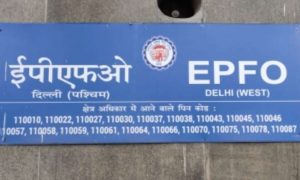Atishi, who became Delhi’s Chief Minister, chose not to sit in former CM Arvind Kejriwal’s seat, honoring his legacy. The BJP criticised her gesture, calling it unnecessary drama.
Atishi, who took oath as the Chief Minister of Delhi on September 21, took charge of her position on Monday. However, Atishi did not sit on former Chief Minister Arvind Kejriwal’s seat, but kept it vacant. Sitting on a different chair, Atishi said she did so because Kejriwal has set an example of dignity in politics by stepping down. Moments later, the Bharatiya Janata Party (BJP) termed it “drama”.
“I will work for four months as the Chief Minister of Delhi like Bharat (in Ramayana) did by keeping Lord Ram’s Khadaun (wooden slipper) on the throne. Arvind Kejriwal has set an example of dignity in politics by stepping down. The BJP left no stone unturned to tarnish his image,” Atishi said after taking charge.
Read More: Two-thirds of UPI users in India may stop using it if transaction fees are introduced: Survey
“Hope people will bring back Kejriwal in February polls, his chair will remain in the Chief Minister’s office till then,” she said.
Meanwhile, the BJP slammed Atishi’s act and said “The drama should stop”.
In an X post, BJP’s IT cell chief Amit Malviya wrote, “This drama in Delhi must stop. Today Atishi Marlena took charge by placing an empty chair next to her Chief Minister’s chair. That means Atishi is the Manmohan Singh of the Delhi government and the real Chief Minister is Arvind Kejriwal, whom the Supreme Court has stopped from going to the Delhi Secretariat, let alone signing files.”
“This is a mockery of the constitution made by Baba Saheb. The oath of office and secrecy of the Chief Minister was taken by Atishi, not by the ghost of Kejriwal sitting on an empty chair,” a rough translation of Malviya’s post in Hindi suggested.
Read More: Railways to launch special ticket-checking drive to combat ticketless travel
In a video, BJP’s Shehzad Poonawala also referred to Atishi as the “new Manmohan Singh” of Delhi.
The Delhi Assembly’s session will be held on September 26 and 27.
Read More: Netflix India Faces Scrutiny For Alleged Visa Violations, Racial Discrimination, And Tax Evasion
THE DELHI CABINET
Atishi has retained the 13 portfolios she held in the Kejriwal government, including those of education, revenue, finance, power and PWD.
Aam Aadmi Party (AAP) leader Saurabh Bharadwaj has eight departments under him, the highest after Atishi, including those of health, tourism, art and culture.
New entrant Mukesh Ahlawat has got the portfolio of labour, SC and ST, employment and land and building departments. Gopal Rai has been given the portfolio of development, general administration department, environment and forest — the portfolios he held in the Kejriwal government. Kailash Gahlot has also retained his previous portfolios — transport, home, administrative reforms, women and child development.
The new cabinet headed by Atishi has a long list of pending projects, schemes and new initiatives to be launched in the next few months before Delhi goes to polls in February next year.
THE RAMAYANA REFERENCE
Bharat, the younger brother of Lord Ram, was the regent of Ayodhya during Ram’s exile. Regarded for his devotion towards his elder brother, Bharat went against his mother and denied the throne of Ayodhya. However, later, Lord Ram told him he was presently living in exile to fulfil his father’s pledge, and that in his absence, his brother should take up the throne.
When Bharat realised that Ram could not be persuaded otherwise, he urged his half-brother to give him his sandals. He proposed to place Ram’s chappals upon the throne of Ayodhya and rule as a regent for the period of Ram’s exile, as an ascetic.
Lord Ram consented to the idea, after which Bharat carried Ram’s sandals upon his head, proceeding to Nandigrama, a village on the outskirts of Ayodhya.
Placing the sandals on the throne to represent Ram, Bharat assumed the regency of Kosala for fourteen years, the kingdom administered from the village.





































